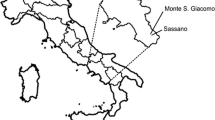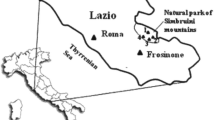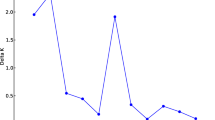Abstract
Phaseolus vulgaris L. is an important species that originated in Mesoamerica. A Mesoamerican and an Andean gene pool are usually distinguished in the domesticated forms. Many bean landraces are still cultivated in Italy and the Department of Applied Biology maintains an ex situ collection of 146 landraces. Although protection schemes are being developed in Italy, most landraces are extinct or at risk of extinction. To facilitate their conservation and use, geographical, morphological, biochemical and molecular (SSR) data were collected and analysed to estimate the diversity and the genetic structure of the collection. Data confirmed that both the Mesoamerican and the Andean gene pools were introduced in Italy and, although a distinction between the two gene pools exists, the Italian landrace diversity is clearly structured in three clusters that are not simply ascribable to the original gene pools. The observed structure appears also to be due to adaptation to the different environmental conditions determined by altitude. This was confirmed by assessing the presence of selective effects for some of the SSR used in this study. Finally, a certain extent of admixture in Italian landrace diversity suggests past (or recurring) hybridisation events among gene pools. The combined use of morphological, biochemical and molecular data clearly distinguished almost all the landraces. The data gathered here can assist landrace in situ protection schemes that are being developed in Italy, be used to register landraces in the European common catalogue of ‘conservation varieties’ for seed commercialisation and contribute to a better use of Italian common bean diversity in breeding for organic and conventional production systems.






Similar content being viewed by others
References
Acherè V, Favre JM, Besnard G, Jeandroz S (2005) Genomic organization of molecular differentiation in Norway spruce (Picea abies). Mol Ecol 14:3191–3201. doi:10.1111/j.1365-294X.2005.02646.x
Angioi SA, Rau D, Attene G, Nanni L, Bellucci E, Logozzo G, Negri V, Spagnoletti Zeuli PL, Papa R (2010) Beans in Europe: origin and structure of the European landraces of Phaseolus vulgaris L. Theor Appl Genet 121:829–843. doi:10.1007/s00122-010-1353-2
Antao T, Lopes A, Lopes RJ, Beja-Pereira A, Luikart G (2008) LOSITAN: a workbench to detect molecular adaptation based on a Fst-outlier method. BMC Bioinformatics 9:323. doi:10.1186/1471-2105-9-323
Beaumont MA, Nichols RA (1996) Evaluating loci for use in the genetic analysis of population structure. Proc R Soc Lond Ser B Biol Sci 263:1619–1626. doi:10.1098/rspb.1996.0237
Beaumont MA, Balding DJ (2004) Identifying adaptive genetic divergence among populations from genome scans. Mol Ecol 13:969–980. doi:10.1111/j.1365-294X.2004.02125.x
Becerra Velásquez VL, Gepts P (1994) RFLP diversity in common bean (Phaseolus vulgaris L.). Genome 37:256–263
Beebe S, Skroch PW, Tohme J, Duque MC, Pedraza F, Nienhuis J (2000) Structure of genetic diversity among common bean landraces of Middle American origin based on correspondence analysis of RAPD. Crop Sci 40:264–273
Bitocchi E, Nanni L, Rossi M, Rau D, Bellucci E, Giardini A, Buonanici A, Vendramin GG, Papa R (2009) Introgression from modern hybrid varieties into landrace populations of maize (Zea mays ssp. mays L.) in central Italy. Mol Ecol 18:603–621. doi:10.1111/j.1365-294X.2008.04064.x
Bitocchi E, Nanni L, Bellucci E, Rossi M, Giardini A, Zeuli P, Logozzo G, Stougaard J, McClean P, Attene G, Papa R (2012) Mesoamerican origin of the common bean (Phaseolus vulgaris L.) is revealed by sequence data. PNAS USA. doi:10.1073/pnas.1108973109
Blair MW, Pedraza F, Buendia HF, Gaitán-Solís E, Beebe SE, Gepts P, Tohme J (2003) Development of a genome-wide anchored microsatellite map for common bean (Phaseolus vulgaris L.). Theor Appl Genet 107:1362–1374. doi:10.1007/s00122-003-1398-6
Blair MW, Iriarte G, Beebe S (2006) QTL analysis of yield traits in an advanced backcross population derived from a cultivated Andean 9 wild common bean (Phaseolus vulgaris L.) cross. Theor Appl Genet 112:1149–1163. doi:10.1007/s00122-006-0217-2
Blair MW, Díaz LM, Buendía HF, Duque MC (2009) Genetic diversity, seed size associations and population structure of a core collection of common beans (Phaseolus vulgaris L.). Theor Appl Genet 119:955–972. doi:10.1007/s00122-009-1064-8
Bonin A, Taberlet P, Miaud C, Pompanon F (2006) Explorative genome scan to detect candidate loci for adaptation along a gradient of altitude in the common frog (Rana temporaria). Mol Biol Evol 23:773–783. doi:10.1093/molbev/msj087
Cockerham CC, Weir BS (1993) Estimation of gene flow from F-statistics. Evolution 47:855–863
Earl DA, vonHoldt BM (2012) STRUCTURE HARVESTER: a website and program for visualizing STRUCTURE output and implementing the Evanno method. Conserv Genet Resour 4:359–361. doi:10.1007/s12686-011-9548-7
Escribano MR, Santalla M, Casquero PA, De Ron AR (1998) Patterns of genetic diversity in landraces of common bean (Phaseolus vulgaris L.) from Galicia. Plant Breed 117:49–56. doi:10.1111/j.1439-0523.1998.tb01447.x
Esquinas-Alcazar JT (1993) Plant genetic resources. In: Hayward MD, Bosemark NO, Romagosa I (eds) Plant breeding: principles and prospects. Chapman & Hall, London, pp 33–51
Evanno G, Regnaud S, Goudet J (2005) Detecting the number of clusters of individuals using the software STRUCTURE: a simulation study. Mol Ecol 14:2611–2620. doi:10.1111/j.1365-294X.2005.02553.x
Excoffier L, Lischer HEL (2010) Arlequin suite ver 3.5: a new series of programs to perform population genetics analyses under Linux and Windows. Mol Ecol Res 10:564–567. doi:10.1111/j.1755-0998.2010.02847.x
Frankel OH, Bennett E (1970) Genetic resources in plants—their exploration and conservation. International Biological Programme Handbook No. 11. Blackwell, Oxford
Gepts P (1988) Origin and evolution of common bean: past events and recent trends. Hort Sci 33:1124–1130
Gepts P, Bliss FA (1986) Phaseolin variability among wild and cultivated common beans (Phaseolus vulgaris) from Colombia. Econ Bot 40:469–478
Gepts P, Bliss FA (1988) Dissemination pathways of common bean (Phaseolus vulgaris, Fabaceae) deduced from phaseolin electrophoretic variability. II. Europe and Africa. Econ Bot 42:86–104
Gepts P, Osborn TC, Rashka K, Bliss FA (1986) Phaseolin-protein variability in wild forms and landraces of the common bean (Phaseolus vulgaris): evidence for multiple centers of domestication. Econ Bot 40:451–468
Hawkes JG, Maxted N, Ford Lloyd BV (2000) The ex situ conservation of plant genetic resources. Kluwer, Dordrecht
IBPGR (1982) Descriptors for Phaseolus vulgaris. IBPGR, Rome
Koinange EMK, Singh SP, Gepts P (1996) Genetic control of the domestication syndrome in common bean. Crop Sci 36:1037–1045. doi:10.2135/cropsci1996.0011183X003600040037x
Kwak M, Gepts P (2009) Structure of genetic diversity in the two major gene pools of common bean (Phaseolus vulgaris L., Fabaceae). Theor Appl Genet 118:979–992. doi:10.1007/s00122-008-0955-4
Lioi L (1989) Geographical variation of phaseolin patterns in an old world collection of Phaseolus vulgaris. Seed Sci Technol 17:317–324
Lioi L, Piergiovanni AR, Pignone D, Puglisi S, Santantonio M, Sonnante G (2005) Genetic diversity of some on-farm survived Italian common bean (Phaseolus vulgaris L.) landraces. Plant Breed 124:576–581. doi:10.1111/j.1439-0523.2005.01153.x
Lioi L, Nuzzi A, Campion B, Piergiovanni AR (2012) Assessment of genetic variation in common bean (Phaseolus vulgaris L.) from Nebrodi mountains (Sicily, Italy). Genet Resour Crop Evol 59:455–464. doi:10.1007/s10722-011-9696-3
Logozzo G, Donnoli R, Macaluso L, Papa R, Knupffer H, Spagnoletti Zeuli PL (2007) Analysis of the contribution of Mesoamerican and Andean gene pools to European common bean (Phaseolus vulgaris L.) germplasm and strategies to establish a core collection. Genet Resour Crop Evol 54:1763–1779. doi:10.1007/s10722-006-9185-2
Mantel N (1967) The detection of disease clustering and a generalized regression approach. Cancer Res 27:209–220
Marino M (2010) Implementazione del Piano Nazionale per la biodiversità in agricoltura. Dal Seme 4:37–41
Masi P, Logozzo G, Donini P, Spagnoletti Zeuli P (2009) Analysis of genetic structure in widely distributed common bean landraces with different plant growth habits using SSR and AFLP markers. Crop Sci 49:187–199. doi:10.2135/cropsci2008.05.0265
McClean PE, Terpstra J, McConnell M, White C, Lee R, Mamidi S (2012) Population structure and genetic differentiation among the USDA common bean (Phaseolus vulgaris L.) core collection. Genet Resour Crop Evol 59:499–515. doi:10.1007/s10722-011-9699-0
Miklas PN, Kelly JD, Beebe SE, Blair MW (2006) Common bean breeding for resistance against biotic and abiotic stresses: from classical to MAS breeding. Euphytica 147:106–131. doi:10.1007/s10681-006-4600-5
Montesano V, Negro D, Sarli G, Logozzo G, Spagnoletti Zeuli PL (2012) Landraces in Inland areas of the Basilicata region, Italy: monitoring and perspectives for on farm conservation. Genet Resour Crop Evol 59:701–716. doi:10.1007/s10722-011-9712-7
Nanni L, Bitocchi E, Bellucci E, Rossi M, Rau D, Attene G, Gepts P, Papa R (2011) Nucleotide diversity of a genomic sequence similar to SHATTERPROOF (PvSHP1) in domesticated and wild common bean (Phaseolus vulgaris L.). Theor Appl Genet 123:1341–1357. doi:10.1007/s00122-011-1671-z
Negri V (2012) Policies supportive of on-farm conservation and their impact on custodians farmers in Italy. In: Padulosi S, Bergamini N, Lawrence T (eds) On farm conservation of neglected and underutilized species: status, trends and novel approaches to cope with climate change. Proceedings of an International Conference, Frankfurt, 14–16 June 2011. Bioversity International, Rome, pp 211–216
Negri V, Tiranti B (2010) Effectiveness of in situ and ex situ conservation of crop diversity. What a Phaseolus vulgaris L. landrace case study can tell us. Genetica 138:985–998. doi:10.1007/s10709-010-9485-5
Negri V, Tosti N (2002) Phaseolus genetic diversity maintained on-farm in central Italy. Genet Resour Crop Evol 49:511–520. doi:10.1023/A:1020902508166
Negri V, Maxted N, Vetelainen M (2009) European landrace conservation: an introduction. In: Vetelainen M, Negri V, Maxted N (eds) European landraces: on-farm conservation, management and use. Bioversity International, Rome, pp 1–22
Papa R, Acosta J, Delgado-Salinas A, Gepts P (2005) A genome-wide analysis of differentiation between wild and domesticated Phaseolus vulgaris from Mesoamerica. Theor Appl Genet 111:1147–1158. doi:10.1007/s00122-005-0045-9
Peakall R (1995) Evolutionary implications of allozyme and RAPD variation in diploid populations of dioecious buffalograss Buchloe dactyloides. Mol Ecol 4:135–147. doi:10.1111/j.1365-294X.1995.tb00203.x
Peakall R, Smouse PE (2006) GENALEX 6: genetic analysis in Excel. population genetic software for teaching and research. Mol Ecol Res 6:288–295. doi:10.1111/j.1471-8286.2005.01155.x
Piergiovanni AR, Laghetti G (1999) The common bean landraces from Basilicata (Southern Italy): an example of integrated approach applied to genetic resources management. Genet Resour Crop Evol 46:47–52. doi:10.1023/A:1008641731573
Piergiovanni AR, Lioi L (2010) Italian common bean landraces: history, genetic diversity and seed quality. Diversity 2:837–862. doi:10.3390/d2060837
Polegri L, Negri V (2010) Molecular markers for promoting agro-biodiversity conservation: a case study from Italy. How cowpea landraces were saved from extinction. Genet Resour Crop Evol 57:867–880. doi:10.1007/s10722-009-9526-z
Pritchard JK, Stephens M, Donnelly P (2000) Inference of population structure from multilocus genotype data. Genetics 155:945–959
Raeymaekers JAM, Van Houdt JKJ, Larmuseau MHD, Geldof S, Volckaert FAM (2007) Divergent selection as revealed by PST and QTL-based FST in three-spined stickleback (Gasterosteus aculeatus) populations along a coastal-inland gradient. Mol Ecol 16:891–905. doi:10.1111/j.1365-294X.2006.03190.x
Rodiño AP, Santalla M, Montero I, Casquero PA, De Ron AM (2001) Diversity of common bean (Phaseolus vulgaris L.) germplasm from Portugal. Genet Resour Crop Evol 48:409–417. doi:10.1023/A:1012248002436
Romero J, Sun S, McLeester R, Bliss F, Hall T (1975) Heritable variation in a polypeptide subunit of the major storage protein of the bean, Phaseolus vulgaris. Plant Physiol 56:776–779
SAS Institute Inc. (1999) SAS/STAT user’s guide. Version 8. SAS Institute Inc., Cary
Scotti-Saintagne C, Mariette S, Porth I, Goicoechea PG, Barreneche T, Bodenes C, Burg K, Kremer A (2004) Genome scanning for interspecific differentiation between two closely related oak species [Quercus robur L. and Q. petraea (Matt.) Liebl.]. Genetics 168:1615–1626. doi:10.1534/genetics.104.026849
Sicard D, Nanni L, Porfiri O, Bulfon D, Papa R (2005) Genetic diversity of Phaseolus vulgaris L. and P. coccineus L. landraces in central Italy. Plant Breed 124:464–472
Singh SP, Gepts P, Debouck DG (1991a) Races of common bean (Phaseolus vulgaris L., Fabaceae). Econ Bot 45:379–396. doi:10.1007/BF02887079
Singh SP, Gutie′rrez JA, Molina A, Urrea C, Gepts P (1991b) Genetic diversity in cultivated common bean: II. Marker-based analysis of morphological and agronomic traits. Crop Sci 31:23–29
Smouse PE, Peakall R (1999) Spatial autocorrelation analysis of individual multiallele and multilocus genetic structure. Heredity 82:561–573. doi:10.1038/sj.hdy.6885180
Storz JF (2005) Using genome scans of DNA polymorphism to infer adaptive population divergence. Mol Ecol 14:671–688. doi:10.1111/j.1365-294X.2005.02437.x
Sun S, Hall T (1975) Solubility characteristic of globulins from Phaseolus seeds in regard to their isolation and characterization. J Agric Food Chem 23:1984–1989
Tamura K, Peterson D, Peterson N, Stecher G, Nei M, Kumar S (2011) MEGA5: molecular evolutionary genetics analysis using maximum likelihood, evolutionary distance, and maximum parsimony methods. Mol Biol Evol 28:2731–2739. doi:10.1093/molbev/msr121
Tiranti B, Negri V (2007) Selective microenvironmental effects play a role in shaping genetic diversity and structure in a Phaseolus vulgaris L. landrace: implications for on-farm conservation. Mol Ecol 16:4942–4955. doi:10.1111/j.1365-294X.2007.03566.x
Tosti N, Negri V (2005) On-going on-farm microevolutionary processes in neighbouring cowpea landraces revealed by molecular markers. Theor Appl Genet 110:1275–1283. doi:10.1007/s00122-005-1964-1
Vasemägi A, Nilsson J, Primmer CR (2005) Expressed sequence tag-linked microsatellites as a source of gene-associated polymorphisms for detecting signatures of divergent selection in Atlantic salmon (Salmo salar L.). Mol Biol Evol 22:1067–1076. doi:10.1093/molbev/msi093
Vitalis R, Dawson K, Boursot P (2001) Interpretation of variation across marker loci as evidence of selection. Genetics 158:1811–1823
Vitalis R, Dawson K, Boursot P, Belkhir K (2003) DetSel 1.0: a computer program to detect markers responding to selection. J Hered 94:429–431. doi:10.1093/jhered/esg083
Yu K, Park S, Poysa V, Gepts P (2000) Integration of Simple Sequence Repeat (SSR) markers into a molecular linkage map of common bean (Phaseolus vulgaris L.). J Hered 91:429–434
Acknowledgments
L. Raggi and B. Tiranti contributed equally to this work and must be considered first authors. The research leading to these results has in part received funding from the European Community’s Seventh Framework Programme (FP7/2007–2013) under the grant agreement n. 245058 SOLIBAM. The Authors wish to thank prof. R. Papa (Università Politecnica delle Marche, Ancona, Italy) for kindly providing the Shatterproof sequences and Dr. G. Logozzo (Università degli Studi della Basilicata, Italy) for profiling the phaseolin pattern of this collection. Thanks are also due to the following people for kindly donating landraces of their genebanks and relative information: Prof. S. Lanteri (Università degli Studi di Torino, Italy), Prof. F. Miceli (Università degli Studi di Udine, Italy), Prof. M. Ciaffi (Università degli Studi della Tuscia, Italy), Prof. P. Spagnoletti Zeuli (Università degli Studi della Basilicata, Italy), Ms R. Turchi (Agenzia Regionale per lo Sviluppo e Innovazione nel Settore Agricolo e Forestale, Florence, Italy), Dr. D. D. Silveri, (Agenzia Regionale per i Servizi di Sviluppo Agricolo Abruzzo, Sulmona, Italy). Thanks are also due to Dr. O. Porfiri and all the farmers who donated their landraces.
Author information
Authors and Affiliations
Corresponding author
Electronic supplementary material
Below is the link to the electronic supplementary material.
Rights and permissions
About this article
Cite this article
Raggi, L., Tiranti, B. & Negri, V. Italian common bean landraces: diversity and population structure. Genet Resour Crop Evol 60, 1515–1530 (2013). https://doi.org/10.1007/s10722-012-9939-y
Received:
Accepted:
Published:
Issue Date:
DOI: https://doi.org/10.1007/s10722-012-9939-y




